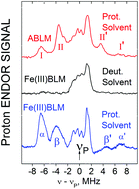Exchangeable proton ENDOR as a probe of the redox-active iron center in activated bleomycin and ferric bleomycin†
Abstract
Activated bleomycin (ABLM) is a drug-Fe(III)-hydroperoxide complex kinetically competent in DNA attack (via H4′ abstraction). This intermediate is relatively stable, but its spontaneous conversion to ferric bleomycin (Fe(III)·BLM) is poorly characterized because no observable intermediate product accumulates. The Fe(III)·BLM formed cryophotolytically from ABLM and kept at 77 K was remarkably similar by EPR and ENDOR criteria to Fe(III)·BLM formed from Fe(III) + BLM solution. The notable ENDOR criteria were the ENDOR frequencies and features of orientation-selected, strongly hyperfine-coupled, exchangeable protons associated with the environs of the iron within <3.5 Å of paramagnetic Fe(III) in Fe(III)·BLM and ABLM. Cryophotolytic conversion of activated bleomycin to its ferric bleomycin product in the frozen solid is a sign that the reaction requires only constrained local proton rearrangements. We have characterized the metal–proton distances and orientations of the protons in that rearrangement, especially noting that these protons are of mechanistic importance in the ambient temperature conversion of ABLM to Fe(III)·BLM in concert with a directed radical-forming attack on DNA.

- This article is part of the themed collection: Frontiers in Spectroscopic Techniques in Inorganic Chemistry


 Please wait while we load your content...
Please wait while we load your content...